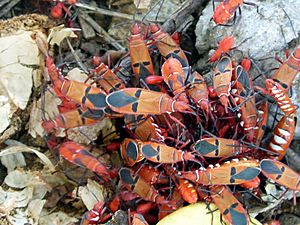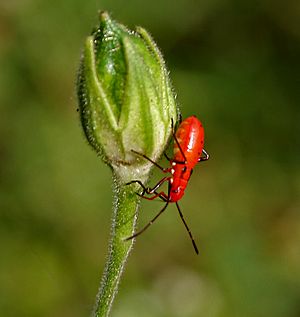Dysdercus koenigii facts for kids
Quick facts for kids Dysdercus koenigii |
|
|---|---|
 |
|
| Adults | |
 |
|
| Nymph on hibiscus | |
| Scientific classification | |
| Genus: |
Dysdercus
|
| Species: |
koenigii
|
The red cotton stainer (Dysdercus koenigii) is a type of true bug. It belongs to a family called Pyrrhocoridae. This bug is known as a pest because it can harm cotton plants. Both the adult bugs and older young bugs (called nymphs) feed on cotton bolls and seeds. When they feed, they can spread tiny fungi that stain the cotton.
Contents
What Does the Red Cotton Stainer Look Like?
The young red cotton stainers are called nymphs. They grow by shedding their skin five times. This process is called moulting.
Nymph Stages
- The first two nymph stages are bright orange or red.
- By the third stage, tiny wing pads start to appear. These nymphs are orange at first, then get darker.
- The fourth stage nymphs are deep red and shaped like a cylinder. Their wing pads are bigger and darker.
- The fifth and final nymph stage looks similar. They have clear dark wing pads, black antennae, and black legs.
Adult Red Cotton Stainers
The adult insect is also a deep red color. It has two black spots on its front wings. When the bug is resting, its thin back wings are hidden under the front ones. Male bugs are about 14 mm (0.55 in) long. Female bugs are a little bit bigger than the males.
Where Do Red Cotton Stainers Live?
You can commonly find Dysdercus koenigii in countries like India and Pakistan. They also live in many parts of southeastern Asia.
What Plants Do They Eat?
The red cotton stainer is known for being a pest of cotton crops. However, cotton is not their favorite food! They actually prefer plants like Alcea rosea (hollyhock) and Hibiscus.
As their favorite plants get older and less suitable for food, the adult bugs fly to new plants. These new plants can be the same kind or different kinds. While they are flying, they often drink nectar from other plants. They also use their beak-like mouthparts, called rostra, to poke into fruits. These fruits are often citrus fruits. This might be because citrus trees and cotton plants are often grown close together.
Red Cotton Stainer Life Cycle
Female D. koenigii bugs usually lay about 70 to 80 eggs at a time. They lay these eggs in damp soil, under dead leaves, or in small cracks.
Egg and Nymph Development
- The eggs are oval-shaped and creamy-yellow.
- They hatch in about six days.
- The nymphs go through five growth stages (instars).
- They become winged adults after about 50 to 60 days.
Adult Life and Feeding Habits
Adult bugs live for a few weeks. There are several generations of these bugs throughout the year. Both the adult bugs and the older nymphs feed on young cotton bolls and the seeds inside. When they are in the cotton bolls, they can introduce fungi like Eremothecium gossypii. This fungus can permanently stain the cotton fibers.

